- Author Jason Gerald [email protected].
- Public 2023-12-16 10:50.
- Last modified 2025-01-23 12:04.
A hurricane is a tropical or subtropical cyclone with wind speeds above 119 kilometers per hour. These storms can form suddenly from a collection of thunderstorms during the hurricane season (usually late summer to early fall). It is better if we are always ready to face it. In order to survive a hurricane, you need to know what preparations you should make before a storm comes, what steps to take when a storm hits, and what actions you should take after the storm has passed.
Step
Part 1 of 3: Prepare Before the Storm
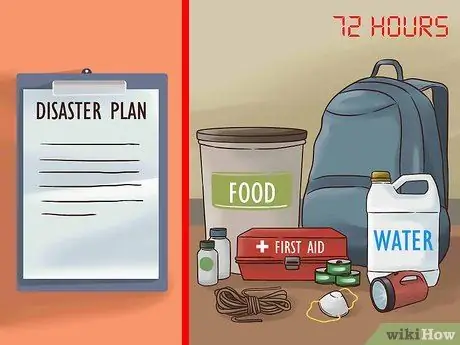
Step 1. Be prepared if you live in an area that experiences frequent storms
Do you live in an area that experiences frequent hurricanes, such as Florida, Georgia, or the Carolinas? Government agencies such as the Federal Emergency Management Agency (FEMA) and the National Oceanic and Atmospheric Administration (NOAA) will give you advice on getting ready for hurricane season (June 1). Your preparation should include a “Family Disaster Preparedness Plan” and an “Emergency Supplies Bag” that can be quickly accessed by the whole family.
- A family disaster preparation plan describes what you will do in an emergency. Plan an evacuation route, for example, and try to choose several alternatives in case the first option doesn't work. Agree on a meeting place if family members are separated.
- Do exercises to teach family members how to turn off water, gas, and electricity. Make sure the youngest family member knows how to contact emergency services.
- An emergency supply bag contains items that must be readily available as soon as possible. The bag should contain the items you need individually for 72 hours, such as food, water, first aid and a flashlight.
- When the winds have reached tropical strength, preparations are no longer possible and you must concentrate on surviving.
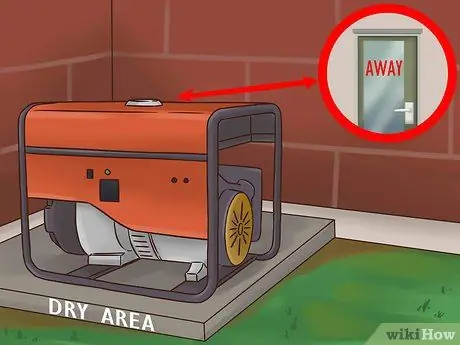
Step 2. Consider buying a generator
The generator will provide electricity after the storm subsides until power returns to normal. Store in a place that is not exposed to rain and overflowing water. Understand how to use it and pay attention to the ventilation provided.
- Always make sure the generator is grounded and in a dry place
- Never plug the generator into ordinary contacts or connect it to the house wiring as this may cause electricity to flow back from the generator to the mains line.
- To reduce the risk of carbon monoxide poisoning, use the generator outdoors, away from doors and windows.
- Ask for a demonstration from the seller if you're not sure how to use it.
- Generators require periodic maintenance and tests. Make sure you follow the instructions to get the generator running when you need it most.
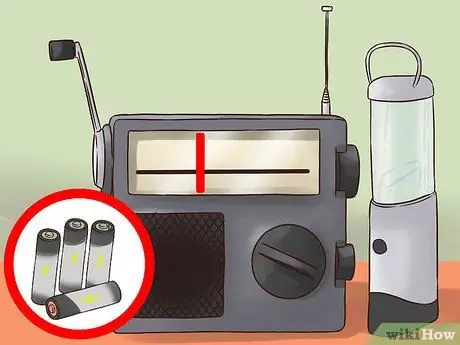
Step 3. Purchase a battery powered radio and flashlight
You will most likely not have electricity during a storm and will not have access to communications or lighting. Consider having a battery-powered or kinetic radio and flashlight.
- NOAA's “All Alerts” weather radio with battery backup is the best option (if you're in the US). This radio will provide periodic information and weather forecasts from NOAA. Set this radio on warning mode during a storm threat and make sure the radio has sufficient power.
- Purchase an efficient battery powered flashlight or a kinetic powered flashlight. The Coleman LED Micropacker is a good choice. This flashlight can illuminate a small area using three AAA batteries for several days. A kinetic powered flashlight uses mechanical energy from an energy-producing device such as a crank and this energy will never run out.
- Light sticks are a safe choice. Due to the risk of gas leaks during storms, you should not use candles.
- Prepare a stock of medium-sized batteries and store them in a waterproof case.
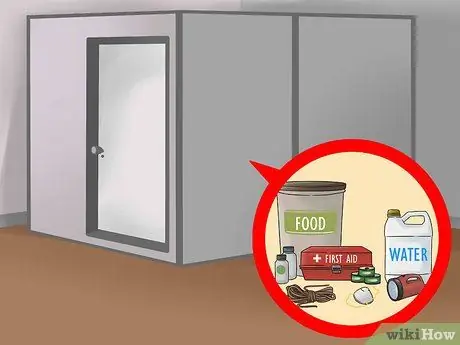
Step 4. Add a “safe space” within your home if possible
A safe room is a structure designed to provide shelter during extreme weather, such as during a tornado or storm. This kind of space is often built as a room in the house. People who take refuge in certified safe spaces generally avoid injury or death during extreme weather.
- The safe space in the house has been “reinforced”. This means the room is strong enough to withstand strong winds. Ceilings, floors, walls, and other features have been thickened or reinforced with concrete.
- Safe spaces can be added to the home or installed. Make sure the room is easily accessible, has a supply of water and other essentials, and is comfortable enough for the users. People often install bathrooms to make this room comfortable.
- Don't have the funds to build a safe space? In the US, the federal government is offering financial assistance to build safe spaces.
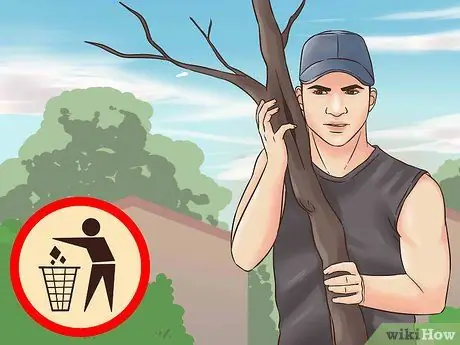
Step 5. Secure your property ahead of time
The majority of damage during a hurricane is caused by strong winds blowing or ripping anything that isn't properly secured. Try to minimize the risk of damage by securing your property before hurricane season arrives.
- Since strong winds can cause trunks and trees to fall, remove any fragile trees that are in your area before hurricane season arrives. Clear any debris that is likely to be carried away by the wind.
- Modify the roof, windows and doors of your home to provide more protection. For example, you can use shatterproof glass, reinforced doors, and window guards to prevent damage.
- You can also ask a building contractor to secure the roof of your house using roof clamps, ridge supports, or storm straps.
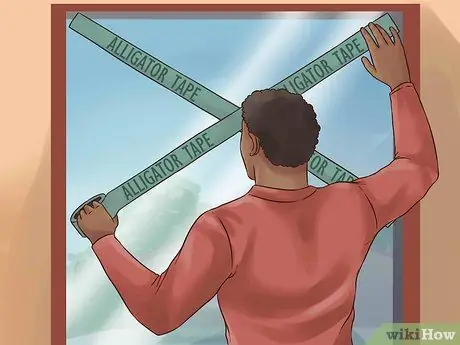
Step 6. Reinforce your home when there is news or a hurricane warning
Take additional steps if you know a storm is coming. Even if you've modified your home to weather a storm, there are other steps you can take to strengthen your home's defenses before the storm hits.
- If you have window guards, cover them. Plywood is the best option and a strong adhesive like alligator tape is a better choice than regular duct tape.
- Tighten water pipes and gutters and remove dirt and blockages. Turn off the entire propane tank.
- Make sure your garage door is completely closed. Do not leave the garage door and seal the opening between the door and the floor; a garage door blown in by the wind can destroy your home.
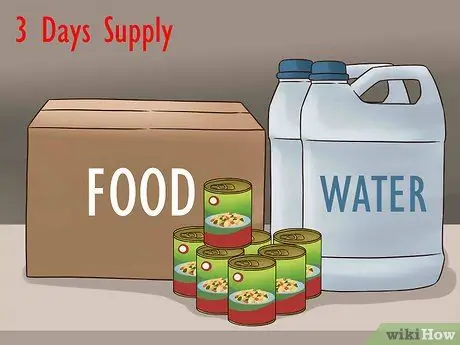
Step 7. Prepare food and water supplies
When the power goes out, your refrigerator won't work, and meat, chicken products, or perishable foods will go bad. Your water flow may be cut off as well. To ensure you survive, stock up on canned and other non-perishable foods and mineral water for at least three days.
- Fill a bottle with drinking water and keep it in your safe. You will need 3.8 liters of water per day per person and you will also need water for cooking and washing. Mark the calendar to make sure you have checked your drinking water adequacy regularly.
- Store a supply of non-perishable food for three days. Non-perishable foods such as canned or freeze-dried foods. Also prepare supplies of pet food.
- When there is a storm warning, clean bathtubs and other water reservoirs with a disinfectant, and fill them with water. This water source may be needed for drinking, bathing, and flushing toilets.
Part 2 of 3: Facing the Storm
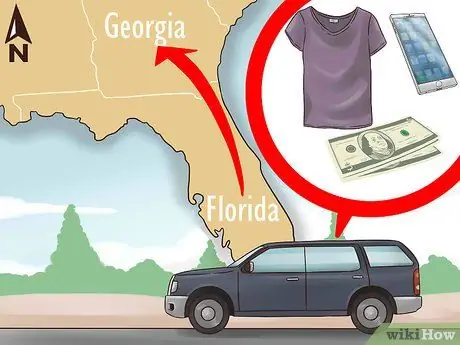
Step 1. Evacuate
If possible, head north to avoid the storm. The storm is likely to have weakened by the time it reaches the region. For example, go to Georgia if you live in the south Florida area or move inland if you live in the Carolinas. It's much easier to keep family and pets together and safe when you're away from a storm than it is when you're in the middle of a storm.
- Stay together. Leave your house together and use a car if you can.
- Always obey evacuation orders. Evacuation should be an even more important priority if you live in a mobile home, even one built after 1994. Even the weakest hurricane, Category 1, can destroy a mobile home..
- Bring the things you really need, such as a cell phone, medicine, identification cards, cash, and maybe some clothes. Bring first aid kit.
- Fully fill the gas tank and do so long before the storm reaches your area. Don't get stuck in your car during a storm.
- Never leave pets. If the pet cannot get out of the rubble, flood, or objects carried by the wind, the pet will be injured or die.
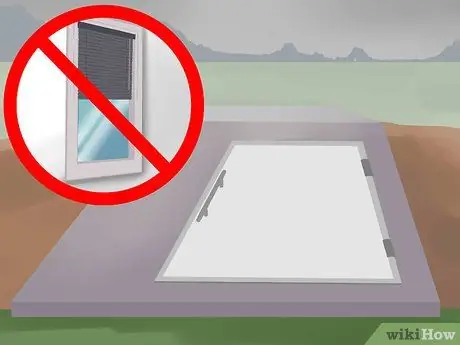
Step 2. Find a shelter
If you decide to stay, you must find a place that will protect you, your family, and your pets during the storm. Shelters should not have windows on either the walls or the roof. If this is in your home, close all interior doors and secure and reinforce all exterior doors.
- Hopefully you have prepared like the steps mentioned above. If you're prepared, you should have a safe place to hide and all the things you need.
- Otherwise, be as prepared as possible in the remaining time you have. Choose a room with strong walls and no windows. You can use an en suite bathroom or cupboard. You can even protect yourself in a ceramic bathtub covered in plywood.
- You can also look for shelters created for the community. Areas that are frequently hit by hurricanes such as Florida have shared shelters for the people of the state. The shelter is open during storms. Find a shelter near where you live and bring medication, insurance documents, identification cards, bedding, flashlights, snacks, and games.

Step 3. Take shelter at least two hours before the storm hits
Don't put it off until the last minute. Get inside the shelter before the storm starts. Bring a battery-powered radio and a battery supply and use them for up-to-date information (every 15 to 30 minutes). By this time, you should be starting to feel the effects of the storm's outer walls.
- Have an Emergency Supplies Bag near you.
- Stay indoors even when the weather seems calm. Weather during a hurricane can subside and worsen suddenly, especially if you pass through the eye of the storm.
- Stay away from wall windows, skylights and glass doors. The greatest risk comes from wind-blown objects or broken glass.
- For added protection, try lying on the floor under a strong object, such as a table.
- During storms, water and lightning carry the risk of electric shock. Turn off main electrical safety circuits and large household appliances if there is no power supply or there is a threat of flooding. Try not to use electrical appliances, telephones, or showers.
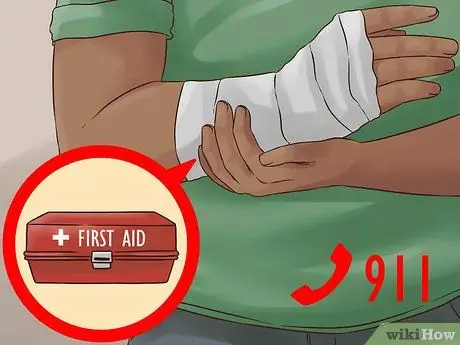
Step 4. Don't travel in an emergency, but ask for help
Many things can happen during a storm. You may be in danger of a storm surge, injured by debris, or facing other medical problems. What should you do if something happens?
- Unless you are threatened by an impending flood, stay indoors. Strong winds and flying objects can injure or even kill you.
- If you're in the US, try calling 911 if you or your family are in a dangerous situation. In Indonesia, you can dial 112. However, bear in mind that telephone lines may not work and emergency services may not be available. For example, thousands of calls to 911 went unanswered during Hurricane Katrina.
- Use the resources you have. Treat the wound as best you can using first aid kits. If you can call 112, they may be able to offer advice or advice for you.
Part 3 of 3: Start Rebuilding
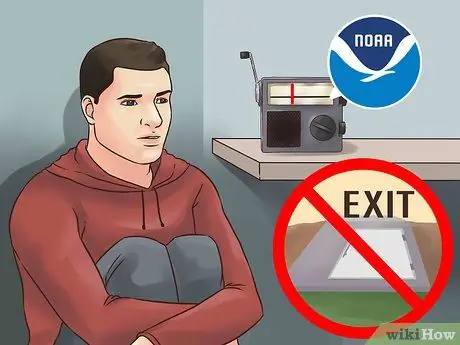
Step 1. Make sure things are safe before you exit
Do not leave a shelter until there is an official "safe" statement from the government. When the wind subsides, you may be in the middle of the eye of the storm. This situation will be followed by a storm wall and strong winds. The storm may only subside after a few hours.
- The area around the eye of the storm is the area where the wind blows the strongest. It can also give rise to a tornado.
- Wait at least 30 minutes after the eye of the storm has passed before entering a windowed room. Even if it subsides, you still have to be very careful-at this point, there's a good chance there will be shards of glass.
-
Be careful even after the "safe" statement. There will still be dangers, such as fallen trees, broken cables and power lines. Do not approach the power cord or line.
Call PLN or emergency services to help you.
- Stay away from areas that are submerged in water. Be careful if you have to enter a submerged area as there may be debris or other unseen hazards.
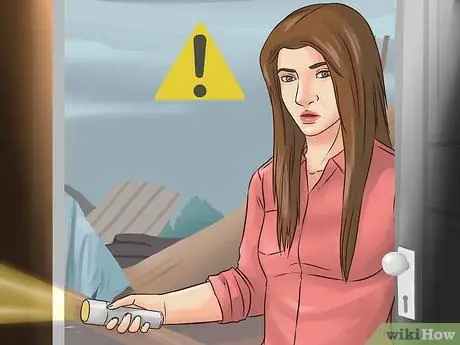
Step 2. Be careful when entering the building
Hurricane winds will damage most of the building structure. Do not enter any building after a storm unless you are absolutely sure that it is safe. Get out of the building as quickly and safely as possible if the building shows signs of damage. The building could collapse.
- Stay away if you smell gas, see a flood, or if a building is damaged by fire.
- It is better to use a flashlight instead of candles, matches, or lanterns. There may be gas leaking and the items could start a fire or cause an explosion. Open windows and doors to allow gas to escape.
- Do not attempt to turn on the power unless you are SURE it is safe to do so. Check the electrical and gas connections before turning it on.
- When entering certain buildings, be careful of loose or slippery floorboards, falling debris, or cracks.
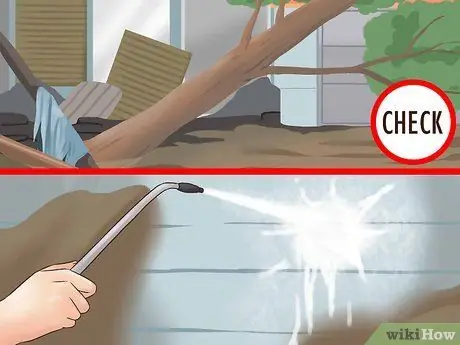
Step 3. Check for damage
Your top priority during a hurricane is to make sure you, your family, and your pets are safe and sound. After you have done that, check for damage. Check your home for damage. If there are things of concern, ask the authorities to look into it as soon as possible and do not approach the area until the area has been repaired.
- Clean and disinfect areas that may be exposed to dirty water, bacteria, or chemical spills. Throw away all spoiled food. If in doubt, throw it away.
- Turn on and secure the water system. Repair damaged sewage tanks and inspect walls for chemical contamination.
- Remove and replace gypsum walls and wet wood that can grow mold.
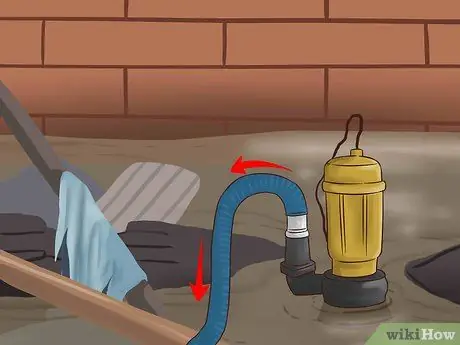
Step 4. Pump out the water flooding the basement
Do not go into a submerged basement. You could be electrocuted and the water could hide debris or contain bacteria from the sewage waste. Use a pump to slowly reduce the water, for example, reduce the water by a third per day, until it has completely subsided.
- Plug the pump into a power source upstairs and start pumping the water out. Make sure the cable is not exposed to water and wear rubber boots.
- If you have a high-power gas pump, insert the hose into the basement through the window.
- If you are unable to drain the basement safely, call the fire department and ask them to do it.

Step 5. Report your loss to the insurance company
You may be able to recover some damages to your home and property if your insurance policy covers flood, wind, and storm damage. Contact your insurance service provider as soon as you can to report the damage.
- List the damages for your insurance claim. Take photos and record damage, keep repair receipts, inventory and even hotel payments.
- If you are vacating the house, make sure your insurance company knows how to contact you. Try contacting them by phone. Many companies provide free telephone lines. Some provide 1-500 (paid) phone numbers.
- If the house is completely damaged, some people even paint the home address and name of the insurance provider on their home to attract the attention of the insurance adjuster.
- Try as much as possible to prevent further damage. For example, cover the damaged roof with tarpaulin and cover the hole with plywood, plastic, or other materials.
Tips
-
Storm season:
- Atlantic Basin (Atlantic Ocean, Caribbean Sea and Gulf of Mexico) and Central Pacific Basin: June 1 to November 30.
- East Pacific Basin (up to latitude 140º West): May 15 to November 30.
- If someone needs your help, such as the elderly or sick, help them take cover.
- Don't leave the house unless you have to. There should be no reason to leave the house until after the storm has subsided.
- Stay alert during hurricane season. BMKG predicts and monitors storm movements throughout the season. Local media is also a good source for information on the estimated path, intensity, and potential impact of storms.
- Check where your pet is and attach identification tools such as a collar or bracelet to make it easier to identify your pet if the animal gets lost or gets lost.
- I live in an area that is frequently hit by hurricanes. All the houses here have a basement. This is the safest place. Watch weather TV channels that provide information about hurricanes. Prepare food supplies and place something in front of your window. Make sure you have a flashlight and battery-powered radio ready so you know what's going on outside.
- When facing a storm, DON'T GET UNDERGROUND! You have to stay above ground to avoid the storm surge. If you live on one of the top floors of an apartment, go down to the lower floor. It's safer to take cover in a smaller building before it's too late.






